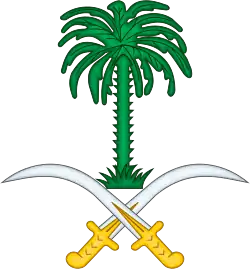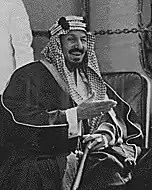Mansour bin Abdulaziz Al Saud
Mansour bin Abdulaziz Al Saud (Arabic: منصور بن عبد العزيز آل سعود Manṣoūr ibn 'Abd al-'Azīz Āl Sa'ūd; 1921 – 2 May 1951) was a member of the House of Saud who served as the defense minister of Saudi Arabia between 1943 and 1951.
| Mansour bin Abdulaziz Al Saud | |||||
|---|---|---|---|---|---|
.jpg.webp) Prince Mansour in 1944 | |||||
| Minister of Defense | |||||
| In office | 10 November 1943 – 2 May 1951 | ||||
| Predecessor | Office established | ||||
| Successor | Mishaal bin Abdulaziz Al Saud | ||||
| Monarch | Ibn Saud | ||||
| Born | 1921 Riyadh | ||||
| Died | 2 May 1951 (aged 29–30) Paris | ||||
| Burial | |||||
| Issue |
| ||||
| |||||
| House | House of Saud | ||||
| Father | Ibn Saud | ||||
| Mother | Shahida | ||||
Early life
Prince Mansour was born in Qasr Al Hukm, Riyadh,[1] in 1921.[2][3] He is widely believed to be the ninth son of Ibn Saud,[4] but William A. Eddy argues that Prince Mansour is the sixth son of Ibn Saud.[5]
His mother was an Armenian woman, Shahida (died 1938),[6][7] who was reportedly the favorite wife of Ibn Saud.[8] She was of Christian origin.[9]
Prince Mansour had two full brothers, Prince Mishaal and Prince Mutaib, and a full sister, Princess Qumash, who died on 26 September 2011.[10][11]
Career
In 1940 Prince Mansour was made minister of war.[12] He was also the emir of Murabba Palace in 1943.[13] He officially visited Cairo.[13] Ibn Saud sent him there to support the Indian Muslim officers and men just before the Battle of El Alamein.[14] Prince Mansour also acted as an aide to Prince Faisal during the latter's post of viceroy of Hijaz.[15]
Then Prince Mansour was appointed minister of defense by Ibn Saud on 10 November 1943 when office was established which had been titled as the ministry of war since 1940.[12][16] Therefore, he is the first defense minister of Saudi Arabia.[17][18] In fact, the body was first named the ministry of defense and aviation.[12] Prince Muhammad and Prince Mansour accompanied Ibn Saud in the latter's meeting with the US President Franklin D. Roosevelt on 14 February 1945.[5][19] He also participated in Ibn Saud's meeting with British Prime Minister Winston Churchill in Egypt in February 1945.[20]
During his term the first Saudi military personnel were sent to the United Kingdom to receive aviation training at several institutions, including the Training University Air Service, near Southampton, and the Academy of Aviation in Perth, Scotland.[21] Prince Mansour visited the latter group.[21] He also officially visited both the United Kingdom and the United States as a guest of these governments, and his visits were concerned with arms deals.[22]
Prince Mansour's term as defense minister lasted until his death in 1951, and he was replaced by his full brother Prince Mishaal who had been his deputy at the ministry.[16]
Personal life
Prince Mansour was married and had two children, Talal and Muhdi.[23] Prince Talal (born 1951) was raised by his uncle Prince Mutaib following the death of his father.[2] Prince Mutaib's daughter, Princess Nouf, married Prince Talal[2] who was made a member of Allegiance Council in December 2007.[24] Prince Mansour's daughter, Mudhi, published a book entitled Al Hijar Wa Natayjiha Fi 'Asir Al Malik 'Abdul'Aziz in 1993.[25]
Death
Prince Mansour died of a heart attack in Paris on 2 May 1951.[2][26] However, an USA diplomatic cable dated 2006 claims that he died of alcohol poisoning after a party hosted by his older half-brother, then governor of Riyadh Nasser bin Abdulaziz.[27] It is further reported that upon hearing of this event, Ibn Saud threw Prince Nasser in jail, and he subsequently lost his post and never returned to public life.[27] Concerning the cause of Prince Mansour's death there is another report arguing that he died of kidney disease.[12][28]
Prince Mansour was buried in Al Adl cemetery, Mecca.[29]
Ancestry
| Ancestors of Mansour bin Abdulaziz Al Saud | |||||||||||||||||||||||||||||||||||||||||||||||||||||||||||||||||||||||||||||||||||||||||||||||||||||||||||||||||||||||||||||||||||||||||||||||||||||||||||||||||||||||||||||||||||||||||||||||||||||||||||||||||||||||||||||||||||||||||||||||||||||||||||||||||||||||||||||||||||||||||||||||||||||||||||||||||||||||||||||||||||||||||||||||||||||||||||||||||||||||||||||||||||||||||||||||||||||||||||||||||||||||||||||||||||||||||||||||||||||||||||||||||||||||||||||||||||
|---|---|---|---|---|---|---|---|---|---|---|---|---|---|---|---|---|---|---|---|---|---|---|---|---|---|---|---|---|---|---|---|---|---|---|---|---|---|---|---|---|---|---|---|---|---|---|---|---|---|---|---|---|---|---|---|---|---|---|---|---|---|---|---|---|---|---|---|---|---|---|---|---|---|---|---|---|---|---|---|---|---|---|---|---|---|---|---|---|---|---|---|---|---|---|---|---|---|---|---|---|---|---|---|---|---|---|---|---|---|---|---|---|---|---|---|---|---|---|---|---|---|---|---|---|---|---|---|---|---|---|---|---|---|---|---|---|---|---|---|---|---|---|---|---|---|---|---|---|---|---|---|---|---|---|---|---|---|---|---|---|---|---|---|---|---|---|---|---|---|---|---|---|---|---|---|---|---|---|---|---|---|---|---|---|---|---|---|---|---|---|---|---|---|---|---|---|---|---|---|---|---|---|---|---|---|---|---|---|---|---|---|---|---|---|---|---|---|---|---|---|---|---|---|---|---|---|---|---|---|---|---|---|---|---|---|---|---|---|---|---|---|---|---|---|---|---|---|---|---|---|---|---|---|---|---|---|---|---|---|---|---|---|---|---|---|---|---|---|---|---|---|---|---|---|---|---|---|---|---|---|---|---|---|---|---|---|---|---|---|---|---|---|---|---|---|---|---|---|---|---|---|---|---|---|---|---|---|---|---|---|---|---|---|---|---|---|---|---|---|---|---|---|---|---|---|---|---|---|---|---|---|---|---|---|---|---|---|---|---|---|---|---|---|---|---|---|---|---|---|---|---|---|---|---|---|---|---|---|---|---|---|---|---|---|---|---|---|---|---|---|---|---|---|---|---|---|---|---|---|---|---|---|---|---|---|---|---|---|---|---|---|---|---|---|---|---|---|---|---|---|---|---|---|---|---|---|---|---|---|---|---|---|---|---|---|---|---|---|---|---|---|---|---|---|---|---|---|---|---|---|---|---|---|---|---|---|---|---|---|---|---|---|---|---|---|---|---|---|---|---|---|---|---|---|---|---|---|---|---|---|---|---|---|---|---|---|---|
| |||||||||||||||||||||||||||||||||||||||||||||||||||||||||||||||||||||||||||||||||||||||||||||||||||||||||||||||||||||||||||||||||||||||||||||||||||||||||||||||||||||||||||||||||||||||||||||||||||||||||||||||||||||||||||||||||||||||||||||||||||||||||||||||||||||||||||||||||||||||||||||||||||||||||||||||||||||||||||||||||||||||||||||||||||||||||||||||||||||||||||||||||||||||||||||||||||||||||||||||||||||||||||||||||||||||||||||||||||||||||||||||||||||||||||||||||||
References
- ""قصر الحكم" يحتفظ بأجمل الذكريات لأفراد الأسرة ... - جريدة الرياض". Al Riyadh (in Arabic). 23 May 2007. Retrieved 26 October 2020.
- Sabri Sharif (2001). The House of Saud in Commerce: A Study of Royal Entrepreneurship in Saudi Arabia. New Delhi: I. S. Publication. ISBN 81-901254-0-0.
- J. Kechichian (2 August 2001). Succession In Saudi Arabia. Springer. p. 182. ISBN 978-0-312-29962-0.
- Nabil Mouline (April–June 2012). "Power and generational transition in Saudi Arabia" (PDF). Critique Internationale. 46: 1–22.
- William A. Eddy (2005). FDR meets Ibn Saud (PDF). Vista: Selwa Press.
- Leslie McLoughlin (21 January 1993). Ibn Saud: Founder of A Kingdom. Palgrave Macmillan UK. p. 144. ISBN 978-1-349-22578-1.
- "Biography of Shahida". Datarabia. Retrieved 10 August 2012.
- Joseph A. Kechichian (2001). Succession in Saudi Arabia. New York City: Palgrave. ISBN 9780312238803.
- Leslie McLoughlin (21 January 1993). Ibn Saud: Founder of A Kingdom. Palgrave Macmillan UK. p. 239. ISBN 978-1-349-22578-1.
- "Custodian of the Two Holy Mosques performs funeral prayer on the soul of Princess Gumash bint Abdulaziz". Riyadh Municipality. 27 September 2011. Retrieved 12 August 2012.
- "The wise leadership dispatch cables of condolences". Arab Today. 28 September 2011. Retrieved 10 October 2020.
- Susan Rose (25 November 2020). The Naval Miscellany: Volume VI. Taylor & Francis. p. 433. ISBN 978-1-00-034082-2.
- "The King of Arabia". Life. 31 May 1943. p. 72. ISSN 0024-3019. Retrieved 10 February 2013.
- George Kheirallah (1952). Arabia Reborn. Albuquerque: University of New Mexico Press. p. 254. – via Questia (subscription required)
- Alejandra Galindo Marines (2001). "The relationship between the ulama and the government in the contemporary Saudi Arabian Kingdom: an interdependent relationship?" (PhD Thesis). Durham University.
- "Royal Saudi Land Forces History". Global Security. Retrieved 21 July 2013.
- Stephanie Cronin (2013). "Tribes, Coups and Princes: Building a Modern Army in Saudi Arabia". Middle Eastern Studies. 49 (1).
- "قصة-السعودية-مع-الوزراء-الثلاثينيين". Al Arabiya. 4 February 2015. Retrieved 28 March 2015.
- Thomas W. Lippman (April–May 2005). "The Day FDR Met Saudi Arabia's Ibn Saud" (PDF). The Link. 38 (2): 1–12.
- "Riyadh. The capital of monotheism" (PDF). Business and Finance Group. Archived from the original (PDF) on 14 October 2009. Retrieved 22 July 2013.
- Haya Saleh Alhargan (2015). "Anglo-Saudi Cultural Relations: Challenges and Opportunities in the Context of Bilateral Ties, 1950-2010" (PhD Thesis). King’s College, University of London. p. 75. Retrieved 10 January 2021.
- Abdullah F. Alrebh (2014). "The public presentation of authority in Saudi Arabia during the 20th century: A discursive analysis of The London Times and The New York Times" (PhD Thesis). Proquest. Retrieved 9 February 2021.
- "Family Tree of Mansur bin Abdulaziz bin Abdul Rahman Al Saud". Datarabia. Retrieved 10 August 2012.
- Simon Handerson (2009). "After King Abdullah" (Policy paper). The Washington Institute. Retrieved 9 August 2020.
- Talal Sha'yfan Muslat Al Azma (1999). "The role of the Ikhwan under 'Abdul'Aziz Al Sa'ud 1916-1934" (PhD Thesis). Durham University. p. 17. Retrieved 4 September 2020.
- "Prince Mansour Dies: 29-Year-Old Son of lbn Saud Is Stricken in Paris". The New York Times. Paris. AP. 3 May 1951. Retrieved 14 September 2020.
- "The new successıon law preserves the monarchy". Wikileaks. 22 November 2006. Retrieved 21 April 2012.
- "Succession in Saudi Arabia" (PDF). Springer. p. 176. Retrieved 14 September 2020.
- "Al-Adl: One of Makkah's oldest cemeteries". Saudi Gazette. 18 June 2012. Archived from the original on 28 July 2013. Retrieved 15 August 2012.

